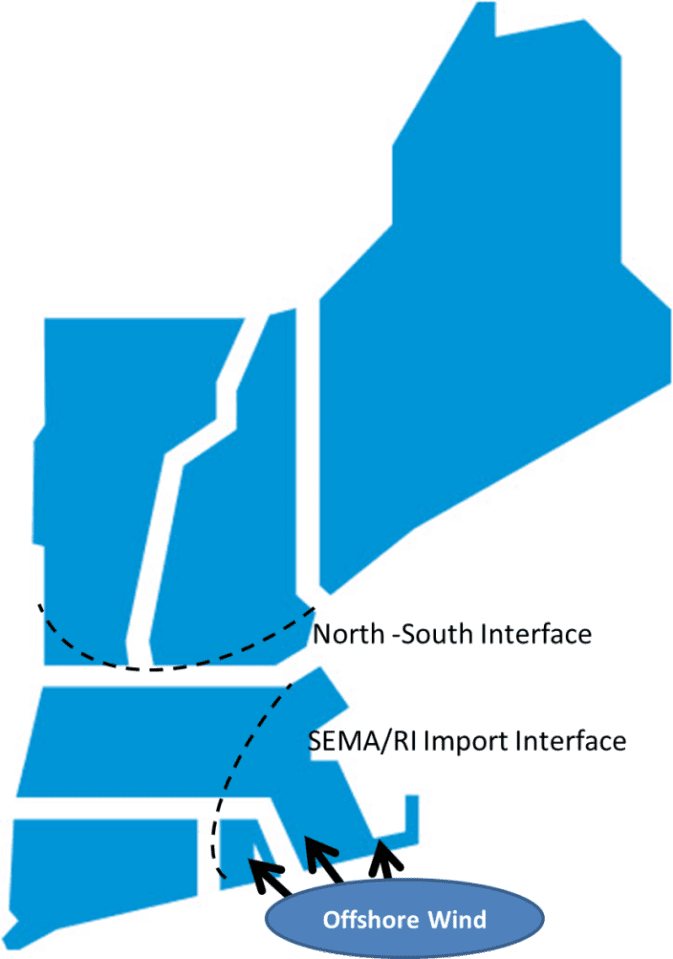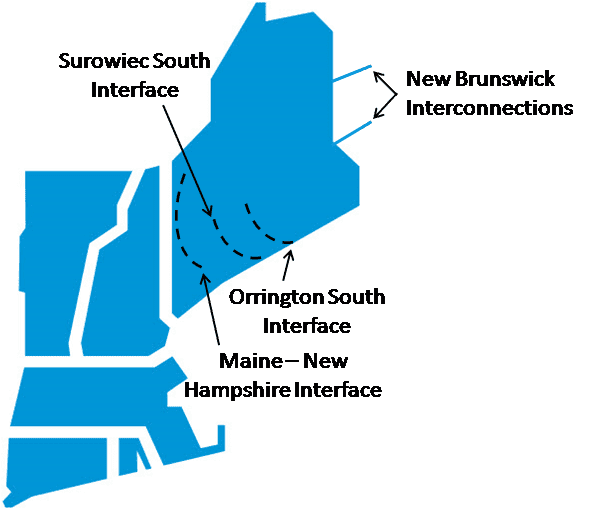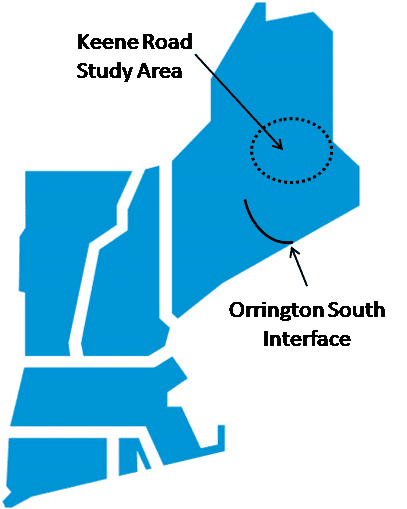Results of three stakeholder-requested economic studies on wind development
 In addition to the engineering studies conducted regularly to ensure long-term reliability of the region’s bulk power system, ISO New England conducts up to three economic studies annually at the request of regional stakeholders. Each study analyzes the economic impacts of a power system scenario developed by those requesting the study. Each study’s scope of work and assumptions of future conditions are largely defined by the requestors, with input from both the Planning Advisory Committee and ISO New England.
In addition to the engineering studies conducted regularly to ensure long-term reliability of the region’s bulk power system, ISO New England conducts up to three economic studies annually at the request of regional stakeholders. Each study analyzes the economic impacts of a power system scenario developed by those requesting the study. Each study’s scope of work and assumptions of future conditions are largely defined by the requestors, with input from both the Planning Advisory Committee and ISO New England.
Although some assumptions and scenarios included in economic studies may not reflect the ISO’s view of likely future system conditions, the study results can provide useful information to stakeholders considering whether and where to develop resources or retire resources on the regional power system, and for policymakers as they consider energy goals and strategies. The studies don’t examine specific generating projects or transmission upgrades, and don’t include individual developer costs, such as the cost of interconnecting to the New England power system.
ISO New England recently completed the three economic studies requested in 2015. The studies focus on the economic impacts of adding more wind resources to the regional power system under a variety of hypothetical scenarios. The studies looked at:
- The potential economic effects of developing offshore wind
- Upgrading transmission at three interfaces in Maine to remove potential bottlenecks and enable the development of more onshore wind and imports from New Brunswick, Canada
- Easing a transmission bottleneck farther north in the Keene Road area of Maine to enable increasing wind development in the local area
Each study considered a variety of hypothetical power system scenarios and then evaluated each of these scenarios for its effects in 2021 on:
- Electricity production costs, taking into account the variable costs of generating electricity, such as the cost of fuel
- Electric energy expenses of New England consumers
- Transmission congestion
- Carbon dioxide (CO2) emissions
The 2015 economic studies, which assumed that wind resources would have the lowest dispatch price and the ability to displace higher-priced resources, show varying levels of benefits from hypothetical scenarios with additions of wind resources in New England. The results of the offshore wind study suggest the region could see sizable economic and environmental benefits from the addition of wind facilities off the coast of Massachusetts and Rhode Island. Two studies on adding onshore wind and easing transmission constraints also show production cost savings, emissions reductions, and other benefits under some hypothetical conditions.
While the 2015 economic studies provide regional stakeholders with important information on the potential economic impact of hypothetical wind development scenarios, they do not include all of the costs associated with each wind development scenario, including the cost of interconnecting a new generating facility to the regional power grid, and the cost of upgrades to ease certain transmission constraints. Further study would be needed to define the work required to fully realize any of these hypothetical scenarios, and the costs.
Further, the 2015 economic study results should be evaluated in the context of the many other studies and reports the ISO has produced regarding wind development in the region. For instance, at the request of the New England governors, ISO New England conducted a comprehensive economic study in 2009 to identify what infrastructure would be needed, and the estimated costs, to integrate significant amounts of renewable energy into the New England power system.
The 2009 Economic Study: Scenario Analysis of Renewable Resource Development focused on the economic impacts of adding onshore and offshore wind, concluding that the power system could incorporate high levels of wind resources—if a significant investment in transmission were made to connect the wind resources in remote areas of New England to population centers. The preliminary, rough estimates of transmission investment needed ranged from $6 billion up to $29 billion, depending on the scenario.
Other relevant ISO studies and reports:
- New England Wind Integration Study, 2010
- Regional System Plans, which contain extensive analyses of the state of the regional power grid
- The 2016 Maine Resource Integration Study (underway)
Offshore Wind Economic Study
The 2015 Economic Study: Evaluation of Offshore Wind Deployment was requested by the Massachusetts Clean Energy Center to evaluate the economic effects of several scenarios of hypothetical wind development off the coast of southern New England.
 Addition of offshore wind.
Addition of offshore wind.
The study examined the economic impacts of adding 1,000 megawatts (MW) and 2,000 MW of wind at offshore facilities and feeding the wind energy into existing substations along the coast of southeastern Massachusetts and Rhode Island. Based on data from the National Renewable Energy Laboratory, the amount of wind energy expected from offshore wind at the time of peak consumer demand was estimated to be between 30% and 37% of its nameplate value. With 1,000 MW (nameplate value) of wind, between 300 MW and 370 MW could be expected.
Based on the study assumptions, the results show reductions in production costs, energy expense, CO2 emissions, and average wholesale electricity prices. The study results for the offshore wind additions also showed reduced congestion on two major transmission interfaces in southern New England.
The study evaluated 15 cases with varying levels of offshore wind and hypothetical future conditions on the regional power system in 2021. The study assumptions included differing future fuel prices, resource retirements, and price levels for CO2 allowances which can, as an expense for generators with higher emissions, increase wholesale electricity prices that provide additional revenues to resources with low or no air emissions. The scenarios ranged from a “business-as-usual” model to a “most favorable to offshore wind” scenario and a “most unfavorable” scenario, with “favorable” and “unfavorable” cases as well.
Results of offshore wind economic study
Production costs. The study simulation found that the addition of 1,000 MW of offshore wind could bring production cost savings ranging from $104 million annually under the scenario least favorable to offshore wind, up to $407 million per year under the scenario with the conditions considered most favorable to offshore wind. With 2,000 MW of offshore wind, the simulations showed estimated production cost savings ranging from $205 million to $807 million per year, based on the study assumptions.
Consumer energy expense. The simulations showed New England-wide consumer energy expense savings ranging from $56 million up to $241 million per year with 1,000 MW of offshore wind, and savings from $128 million to as much as $491 million per year with 2,000 MW.
CO2 emissions. Because the energy generated by offshore wind facilities would primarily displace energy from generators that produce emissions, such as coal-, oil-, and natural-gas-fired power plants, the study results indicate that the addition of offshore wind could result in lower CO2 emissions. With 1,000 MW of offshore wind, the simulations showed CO2 emissions reductions ranging from 1,518 kilotons per year (kton/year) to 2,132 kton/year. With 2,000 MW of wind, the simulations showed CO2 emissions declining by 3,034 kton/year to as much as 4,230 kton/year.
Average wholesale prices. Offshore wind, with no fuel costs, was assumed to have a price of $0 per megawatt-hour (MWh) and at that price wind generation displaced higher-priced generators, resulting in lower average wholesale power prices in New England, according to the study.
Potential revenues. The study also estimated revenues that would accrue to offshore wind facilities under the various scenarios. With the assumptions used in the study, revenues ranged from $83 million under the least favorable conditions to $376 million per year with 1,000 MW of wind under the most favorable circumstances, and from $160 million to $732 million with 2,000 MW of offshore wind.
Onshore Wind Economic Studies
The ISO conducted two economic studies that simulated the addition of onshore wind energy while easing transmission constraints in Maine.
 Interfaces evaluated in northern Maine.The 2015 Economic Study Strategic Transmission Analysis—Onshore Wind Integration, requested by RENEW Northeast, evaluated the economic impact of adding onshore wind farms in Maine along with the effect of relieving potential bottlenecks at three major Maine transmission interfaces.
Interfaces evaluated in northern Maine.The 2015 Economic Study Strategic Transmission Analysis—Onshore Wind Integration, requested by RENEW Northeast, evaluated the economic impact of adding onshore wind farms in Maine along with the effect of relieving potential bottlenecks at three major Maine transmission interfaces.
The study explains that inexpensive electric energy generated in northern Maine and imports from New Brunswick crosses a number of potentially constraining interfaces, including the Orrington South interface. Competition for limited export capability across the Maine transmission corridor results in bottled-in energy (for example, wind, hydro, and imports), which necessitates the use of higher-cost fossil fuel resources. The results of the study showed that easing transmission constraints would reduce bottled-in wind energy, which would then reduce fossil fuel consumption in southern New England.
The 2015 Economic Study Strategic Transmission Analysis—Onshore Wind Integration looked at the impacts of increasing transfer capability at the three major Maine interfaces: Orrington South increased by 325 MW to 1,650 MW; Surowiec South increased by 500 MW to 2,100 MW; and the Maine-New Hampshire interface increased by 400 MW to 2,300 MW. The study looked at hypothetical transfer levels and did not identify specific transmission upgrades that would be required.
 The Keene Road export-constrained area in northern Maine.The other economic study of onshore wind integration, 2015 Economic Study: Evaluation of Increasing the Keene Road Export Limit, was conducted in response to a request from SunEdison to study the effect of easing a transmission bottleneck at an interface in the Keene Road area, along with a limited number of wind development scenarios. Keene Road is a smaller area in northern Maine, north of the three major interfaces examined in the other study. When the study assumptions were developed in 2015, the Keene Road area had a peak load of about 38 MW, while 292 MW of resources were located behind the Keene Road transmission interface, including 147 MW of wind. The simulations limited energy exports over the Keene Road transmission system to 165 MW. At the time, wind projects totaling another 53 MW were proposed, which would bring total wind in the Keene Road area to 200 MW.
The Keene Road export-constrained area in northern Maine.The other economic study of onshore wind integration, 2015 Economic Study: Evaluation of Increasing the Keene Road Export Limit, was conducted in response to a request from SunEdison to study the effect of easing a transmission bottleneck at an interface in the Keene Road area, along with a limited number of wind development scenarios. Keene Road is a smaller area in northern Maine, north of the three major interfaces examined in the other study. When the study assumptions were developed in 2015, the Keene Road area had a peak load of about 38 MW, while 292 MW of resources were located behind the Keene Road transmission interface, including 147 MW of wind. The simulations limited energy exports over the Keene Road transmission system to 165 MW. At the time, wind projects totaling another 53 MW were proposed, which would bring total wind in the Keene Road area to 200 MW.
Results of the 2015 Economic Study Strategic Transmission Analysis—Onshore Wind Integration
Based on the assumptions used, the 2015 economic study of three major Maine interfaces indicated that increasing transmission capability at the three interfaces could increase the amount of less-costly generation and imports able to serve New England and reduce the use of fossil-fuel fired electricity generation. Production cost savings ranged from $200,000 to about $78 million annually, depending on the scenario and assumptions, while easing the transfer limits in Maine could result in more frequent bottlenecks at a major interface farther south in New England.
The study looked at seven wind development scenarios, starting with a base case using the 453 MW of wind in Maine at the time, including 181 MW north of the Orrington South interface. The scenario with the highest level of wind examined the impact of adding all 4,405 MW of wind projects proposed as of April 1, 2015, including 3,727 MW of wind proposals in Maine with 2,829 MW north of Orrington. Another scenario posited a case with all the proposed wind plus 1,000 MW of low-cost, dispatchable energy imports from New Brunswick.
Production costs. Based on the study assumptions, easing the three transmission interface limits in Maine could result in production cost savings of $200,000 to $4.6 million annually when less than 1,149 MW of wind are in the state, including 334 MW located north of the Orrington South interface. With more than 2,084 MW of wind resources in Maine, including more than 1,185 MW north of Orrington South, the annual savings increased from $38 million to $75 million. The scenario adding all the proposed wind and 1,000 MW of imports from New Brunswick showed potential savings of up to $78 million annually.
Consumer energy expense. Based on the study assumptions, New England-wide consumer energy expense savings would range between $500,000 up to a high of $79.6 million annually.
CO2 emissions. The study simulations found that easing transmission constraints and adding wind resources at the three lower levels of wind development would reduce carbon dioxide emissions by about 2.6 kton/year or increase them by up to 7.3 kton/year. The differing scenarios resulted in changes in how generators on the system were dispatched in the simulation, resulting in the lowest possible production costs, not necessarily the lowest emissions. At the three higher levels of wind additions, the study showed emissions reductions from 216 kton/year up to about 700 kton/year.
Average wholesale prices. Average wholesale electricity prices for New England as a whole could decline slightly with the addition of more wind and transmission upgrades to ease the bottlenecks in Maine, based on the study assumptions.
Bottled-in energy in Maine. The study’s simulations found that increasing transfer capability at the major interfaces did not significantly change the amount of Maine wind energy bottled-in by transmission constraints. That’s because thermal limits on local transmission lines nearer to wind resources could prevent them from producing all their energy possible. The greatest reduction in bottled-in wind energy was a decline of 700 gigawatt-hours (GWh), from 1,641 GWh to 941 GWh, in the scenario with the highest level of wind development.
Based on the assumptions used, the study also found that as the Maine corridor was upgraded to allow higher levels of energy from wind resources to flow, the North–South interface farther downstream along the southern borders of New Hampshire and Vermont was more frequently constrained.
Transmission investment. With the study assumptions used, the production cost savings at the three lowest levels of wind additions would support investment in transmission upgrades of about $1.3 million to $7.9 million. The results showed that at the higher levels of wind development, transmission investments ranging from $195.1 million up to $555.7 million could be supported.
Results of the 2015 Evaluation of Increasing the Keene Road Export Limit study
Based on the study assumptions, increasing the Keene Road interface limit from 165 MW to 225 MW reduced production costs as much as $5.7 million, which would support investment in transmission upgrades of as much as $40.5 million. The study results indicate that production cost savings don’t necessarily increase with the addition of wind energy or easing of the Keene Road interface limit because allowing more energy to flow from Keene Road could result in constraints at the Orrington South interface, farther downstream, for a significant number of hours. The other economic study of onshore wind, 2015 Economic Study Strategic Transmission Analysis—Onshore Wind Integration, examines the effect of increased transfer limits at Orrington South.
The ISO intends to conduct further analysis of the Keene Road area to determine whether there is a need for a potential market-efficiency transmission upgrade. Market-efficiency transmission upgrades are focused primarily on reducing electric energy production costs in New England, rather than addressing a reliability concern.
The Keene Road study examined 15 hypothetical cases, including increased transmission transfer limits and varying levels of wind resources (878 MW, 971 MW, 1,345 MW, and 4,405 MW in New England as a whole, with either 147 MW or 200 MW in the Keene Road area). One scenario also evaluated the development of all the wind proposed for New England as of April 1, 2015 (4,405 MW) as well as 1,000 MW of imports from New Brunswick.
Production costs. The simulation suggests that raising the Keene Road interface export limit from 165 MW to 225 MW would reduce production costs by about $1.6 million a year with 147 MW of wind, and by about $5.7 million with 200 MW of wind and an unconstrained Keene Road export interface.
The results for the two highest wind and export capability scenarios studied did not show any reduction in production costs because more frequent congestion at the Orrington South interface could prevent or limit the export of power farther south.
Consumer energy expense. The simulation indicates that easing the Keene Road bottlenecks would have a wide range of effects on consumers’ energy expense, ranging from an increase of $2.1 million per year in one case to a reduction of $3.1 million annually in another. In the case showing a potential increase in energy expense, higher prices could result in a local area when transmission bottlenecks are eased, allowing bottled-in energy to flow out. When an area has bottled-in energy, inexpensive supply is available to meet local demand and prices will be lower in that export-constrained area, but higher outside it. Prices in the local area will tend to rise when bottled-in, inexpensive energy can flow out of the area. In some instances, the study simulation indicated that the rest of the region could see slightly lower prices, but not low enough to counterbalance the price increase that could occur in the formerly export-constrained area.
CO2 emissions. Based on the scenario, systemwide CO2 emissions showed no change or would fall by 57.4 kton per year, depending on the case.
Average wholesale prices. The study simulation indicates that as more wind is added and transmission bottlenecks are eased in the Keene Road area, average prices in New England as a whole would shift up or down slightly, or would not change at all, depending on the case.
Transmission investment. In the case with 1,000 MW of imports and significantly more wind added north of the Orrington South interface, no capital investment in transmission upgrades in the Keene Road area could be supported by the production cost savings. In the cases with additional wind added only behind the Keene Road interface, investment in transmission upgrades, between $32.4 million and $40.5 million in transmission upgrades could be supported by the production cost savings.
- Categories
- Publications
- Tags
- planning advisory committee, renewable resources, transmission planning, wind
